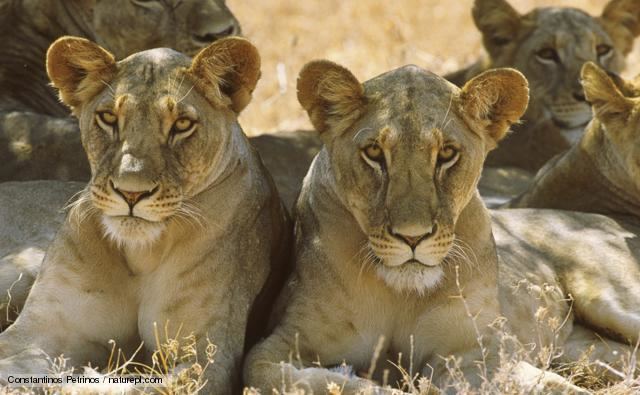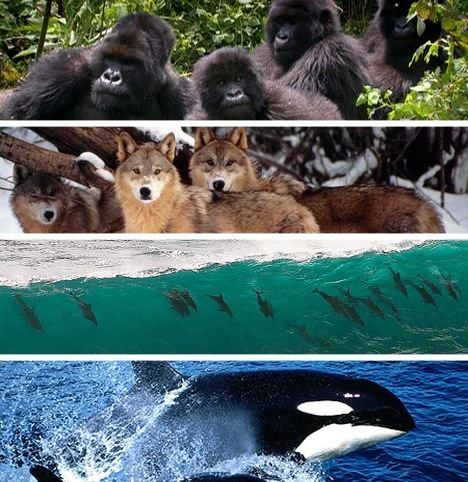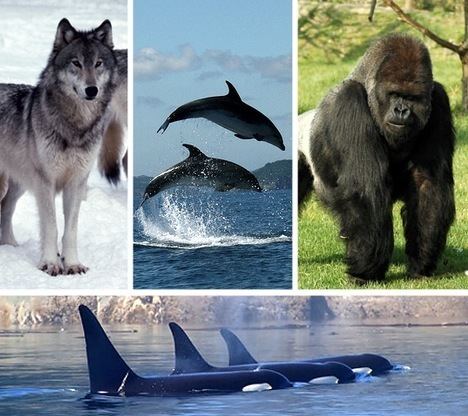 | ||
Lifespan Human: 79 years, Spotted hyena: 12 years Height Human: 1.7 m, Neanderthal: 1.6 – 1.7 m Mass Neanderthal: 78 kg, Spotted hyena: 44 – 64 kg Gestation period Spotted hyena: 110 days, Bonobo: 240 days Speed Human: 45 km/h, Spotted hyena: 60 km/h Length Spotted hyena: 95 – 170 cm, Bonobo: 70 – 83 cm Representative species Human, Neanderthal, Spotted hyena, Bonobo, Upright man | ||
David brooks the social animal
Social animals are those animals which interact highly with other animals, usually of their own species (conspecifics), to the point of having a recognizable and distinct society. Many animals are social to the extent that mothers and offspring bond, and males and females interact to mate, but the term "social animal" is usually only applied when there is a level of social organization that goes beyond this, with permanent groups of adults living together, and relationships between individuals that endure from one encounter to another. In the case of social animals, not having those social interactions can be detrimental to the animal's development; they are crucial. These interactions and socializing help to develop emotional stability and flexibility for the span of the animal's life.
Contents
- David brooks the social animal
- Eusociality
- Presociality
- Rhesus macaques
- Abnormal development
- Vampire bats
- Invertebrates
- Vertebrates
- Human social behavior
- References

The antonym to a social animal is a solitary animal. Some insects such as the locust have both solitary and gregarious phases.

Sociality refers to the extent of organization of their social behavior. The levels of sociality include eusocial, presocial (solitary but social), subsocial, and parasocial (including communal, quasisocial, and semisocial). Animal social behavior and organization is studied in comparative psychology, ethology, sociobiology, behavioral ecology and computer science (artificial intelligence).

Eusociality
Eusociality is the highest level of social organization. It is characterised by:

A few species, notably insects of the orders Hymenoptera (ants, bees and wasps) and Isoptera (termites) show an extreme form of sociality, involving highly organized societies, with individual organisms specialized for distinct roles. This form of social behaviour is referred to as eusociality. In termites, labour is divided amongst different castes, including reproductive 'queens' and 'kings', and non-reproductive workers and soldiers. Only two rodent species, the naked mole-rat and the Damaraland mole-rat, are known to be eusocial. One species of weevil, Austroplatypus incompertus, has been described as eusocial.
Presociality
Presociality is when animals exhibit more than just sexual interactions with members of the same species, but fall short of qualifying as eusocial. That is, presocial animals can display communal living, cooperative care of young, or primitive division of reproductive labour, but they do not display all of the three essential traits of eusocial animals. Examples include numerous insects, especially hymenoptera (ants, bees and wasps), humans, many birds and chimpanzees. Humans and some species of Callitrichidae are unique among primates in their degree of cooperative care of young. Some insects such as locusts can become gregarious, swarming in huge numbers in response to overcrowding, but are otherwise solitary and exhibit little social behaviour.
Rhesus macaques
Rhesus macaque troops comprise a mixture of 20–200 males and females. Females may outnumber the males by a ratio of 4:1. Males and females both have separate hierarchies. Females have highly stable matrilineal hierarchies in which a female’s rank is dependent on the rank of her mother. In addition, a single group may have multiple matrilineal lines existing in a hierarchy, and a female outranks any unrelated females that rank lower than her mother. Rhesus macaques are unusual in that the youngest females tend to outrank their older sisters. This is likely because young females are more fit and fertile. Mothers seem to prevent the older daughters from forming coalitions against her. The youngest daughter is the most dependent on the mother, and would have nothing to gain from helping her siblings in overthrowing their mother. Since each daughter had a high rank in her early years, rebelling against her mother is discouraged. Juvenile male macaques also exist in matrilineal lines, but once they reach four to five years of age, they are driven out of their natal groups by the dominant male. Thus, adult males gain dominance by age and experience.
Abnormal development
Harry Harlow set up an experiment with rhesus monkeys in 1958. He gave them a choice of a wire mother with a food bottle attached and a similar wire mother wrapped in terry towelling. He found that for 18 hours a day the monkeys cling to the wire mother with terry towelling, so concluded that attachment is not always about food and feeding but that attachment exist when contact comfort is present. The contact comfort is the comfort that is derived from physical closeness with a caregiver. Results from this study showed that social encounters are necessary in order for the young monkeys to develop both mentally and sexually.
Vampire bats
Vampire bats, (Desmodus rotundus), are extremely sociable animals which tend to live in colonies in dark places, such as caves, old wells, hollow trees, and buildings. Vampire bat colony numbers can range in the thousands in roosting sites. The basic social structure of roosting bats is made of harems, which are composed of females and their offspring and a few adult males, known as "resident males" and a separate group of males, known as "non-resident males". In hairy-legged vampire bats, the hierarchical segregation of non-resident males is less strict than in common vampire bats. Nonresident males are accepted into the harems when the ambient temperature lowers. This behavior suggests social thermoregulation.
Resident males mate with the females in their harems, but it is common for outside males to copulate with the females. Female offspring usually remain in their natal groups unless their mothers die or move. Several matrilines can be found in a group, as unrelated females regularly join groups. Male offspring tend to live in their natal groups until they are about two years old, sometimes being forcefully expelled by the resident adult males.
A vampire bat can only survive about two days without a meal of blood, yet they cannot be guaranteed of finding food every night. This poses a problem, so when a bat fails to find food, it will often "beg" another bat for food. The "host" bat may regurgitate a small amount of blood to sustain the other member of the colony. This has been noted by many naturalists as an example of reciprocal altruism in nature. This regurgitation behavior is carried out among bats maintaining a long-term association with one another. Studies have shown that bats will not share their resources equally but will share more often with those that they know they will encounter again, as well as relatives. Therefore, if the same bat is unsuccessful on a following hunt, the bats it is associated with will also share their resources. By reciprocating to one another so that all remain fed, the strength of the vampire bat colony as a whole is steadily increased with no individual bats suffering.
Invertebrates
Many hymenopteran species and some other insect species are known for their eusocial behavior (see above). Other social invertebrates include thrips, pistol shrimps, certain spiders, trematodes and velvet worms.
Vertebrates
Examples of social vertebrates include bats (Chiroptera), cacatuidae (cockatoos), callitrichidae monkeys, including some species of tamarin and marmoset, crows, dolphins (Delphinidae), domestic cats, domestic dogs, domestic mouse (house mouse (Mus musculus)), elephants (Loxodonta africana) (Elephas maximus) (Loxodonta cyclotis), european starling (Sturnus vulgaris), gerbils, guinea pigs (Cavia porcellus), Hominidae, including: bonobos and chimpanzees (Pan), gorillas (Gorilla gorilla), and humans (Homo sapiens), horses (Equus ferus), hyenas (Hyaenidae), killer whales (Orcinus orca), Leporidae (rabbits and hares), lions (Panthera leo), meerkats (Suricata suricatta), orange-fronted conures (Aratinga canicularis), Paracheirodon, tetras, penguins (Spheniscidae), Psittacidae (parrots), rats (Rattus), sea otters, wolves, zebra finches (Taeniopygia guttata)
Human social behavior frequently includes non-human animals (most notably cats, dogs and horses). Animals can provide humans with companionship as pets, or can be kept as livestock, service animals for disabled people, or working animals to perform labor. In many cultures, humans have used animals in religious sacrifice or in staged fights and shows for entertainment such as circuses. A chief debate among ethologists studying animal societies is whether non-human primates and other animals can be said to have culture.
Other animal species may interact cooperatively in symbiotic relationships.
Human social behavior
Human social behavior is an extensively studied topic involving many academic disciplines in the social sciences. Anthropology is the most general field studying humans and their social behavior, whereas economics, linguistics, psychology, and political science, and many others, focus more narrowly on aspects of small-group and large-group social behavior.
